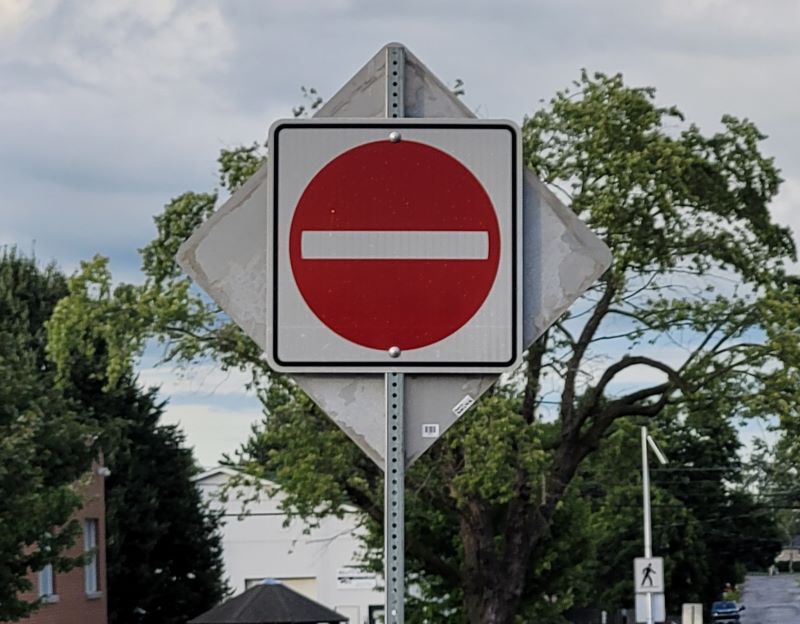A red circle with a horizontal white bar going across the centre. It’s a road sign. There is an entire chapter on road signs in Ontario’s driving handbook. There are unsurprisingly very many signs, and a great deal of them contain no words. Why? Road signs that exclusively use pictures and symbols can be adopted universally, to prevent language barriers from translating into driving barriers for those who don’t speak the language in which a country’s signs are written.
 The red circle with a horizontal white bar going across the centre translates into English as “do not enter”. It’s an important sign that is usually placed at the opening of one-way streets to indicate that proceeding forward or turning onto the street will result in driving the wrong way down a one-way street. These signs are visible at the intersections of York St and Louise St, looking east, and Louise St and Clarence St, looking south.
The red circle with a horizontal white bar going across the centre translates into English as “do not enter”. It’s an important sign that is usually placed at the opening of one-way streets to indicate that proceeding forward or turning onto the street will result in driving the wrong way down a one-way street. These signs are visible at the intersections of York St and Louise St, looking east, and Louise St and Clarence St, looking south.
In a place like North Dundas, people are not accustomed to “city things” like one-way streets, but the respective sections of York St and Louise St S are exactly that, in order to permit parking for the elementary school and its new adjoining child care centre. The one-way traffic on the two streets has been in place for two years now. Drivers still drive the wrong way on these streets routinely. A handful of offences per year would be understandable, especially in a section of Winchester where many “outsiders” who are unfamiliar with the territory visit to go to the hospital. However, it is my estimate that 5-10 cars per day drive the wrong way down York and Louise streets.
My job involves spending about two hours per day in the adjacent soccer field, and I have observed an average of 2-3 vehicles driving the wrong way on York St each day during that two hour span. Given that it is a busy time of day, it would be unfair to extrapolate too extremely, but I think that an estimate of 5-10 violations per day is reasonable.
There is a crosswalk on York St, and parents of any children who use that crosswalk should remind them to look both ways – not just the way traffic is supposed to come from. There is crosswalk signage for motorists travelling the wrong way, but it is not as thorough, and the warning light system appears only for drivers travelling the correct way. It is also reasonable to assume that drivers who did not notice two large “do not enter” signs may not notice children suddenly appearing from the visual cover of parked cars to cross the street. Since York St is only one lane, plus a painted no-travel area and parking spaces, cars which drive the wrong way must pull over into the no-travel area when they meet an oncoming car. I have seen it happen far more times than any one person should. I often wonder how many of the wrong-way drivers are screaming “stay in your lane!” to their fellow motorists coming at them from the only lane in the only legal direction of travel.
What do these frequent one-way-street violations mean? It’s possible that people are violating the law on purpose, but it’s also highly unlikely. More probable is that drivers don’t know what a red circle with a horizontal white bar going across the centre actually translates to in English. Would the actual words “Do Not Enter” written above the signage help? What about the words “Wrong Way”? I would enthusiastically support the argument that those who don’t know what road signs mean should not be driving, but unfortunately, confiscating the driver’s licenses of hundreds of thousands of road users would not be practical.
Council is aware of the issue, as Councillor Matthew Uhrig brought it up in the July 11 Council meeting after noticing the wrong way traffic himself when dropping off his own children. While Councillor Uhrig’s question of what additional measures could be put in place was not directly answered, it was suggested that the Township’s new liaison officer, Sgt Alicia Burtch, could be a good point of contact for anyone noticing violations. Additionally, Mayor Fraser suggested that people log and track incidents of one-way traffic that they witness to make the OPP’s enforcement duties easier.
